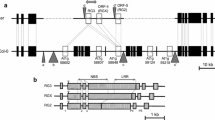Abstract
Expression of open reading frame (ORF) VI of cauliflower mosaic virus (CaMV) in transgenicArabidopsis thaliana caused a typical syndrome characterised by leaf chlorosis, vein clearing, plant stunting and reduced fertility. In addition and in comparison to untransformed controls we observed the formation of much larger rosettes of leaves combined with much later flowering and more extensive tillering. In these aspects, the ORF VI transgenic plants resembled late flowering mutants. All these phenotypes correlated with expression of ORF VI in three lines of transgenic plants which were produced independently, with different Ti-plasmid derived vectors and with different selective markers. The late flowering phenotype cosegregated with the transgene.
Similar content being viewed by others
References
Martinez-ZapaterJ.M. and SommervilleC.R., Plant Physiol92, 770–776, 1990.
KoornneefM., HanhartC.J., and van derVeenJ.H., Mol Gen Genet229, 57–66, 1991.
SungZ.R., BelachewA., ShunongB., and Bertrand-GarciaR., Science258, 1645–1647, 1992.
BurnJ.E., BagnallD.J., MetzgerJ.D., DennisE.S., and PeacockW.J., Proc Natl Acad Sci USA,90 287–291, 1992.
ShepherdR.J., RichinsR.D., and ShallaT.A., Virology102, 389–400, 1979.
SchoelzJ.E. and ShepherdR.J., Virology162, 30–37, 1988.
SchoelzJ.E., ShepherdR.J., and DaubertS.D., J. Mol Cell Biol6, 2632–2637, 1986.
OlszewskiN., HagenG., and GuilfoyleT.J., Cell29, 395–402, 1982.
CoveyS.N. and HullR., Virology111, 463–474, 1981.
OdellJ.T. and HowellS.H., Virology101, 349–359, 1980.
Kiss-LászlóZ., BlancS., and HohnT., EMBO J14, 3553–3562, 1995.
DaubertS.D., SchoelzJ.E., DebaoL., and ShepherdR.J., J Mol Appl Genet2, 537–547, 1984.
StratfordR. and CoveyS.N., Virology172, 451–459, 1989.
GoldbergK.B., KiernanJ., and ShepherdR.J., Molecular Plant-Microbe Interactions4, 182–189, 1991.
BonnevilleJ-M., SanfaçonH., FüttererJ., and HohnT., Cell59, 1135–1143, 1989.
GowdaS., WuF.C., ScholthofH.B., and ShepherdR.J., Proc Natl Acad Sci USA86, 9203–9207, 1989.
FüttererJ. and HohnT., EMBO J10, 3887–3896, 1991.
ScholthofH.B., GowdaS., WuF.C., and ShepherdR.J., J Virology66, 3131–3139, 1992.
ZijlstraC. and HohnT., Plant Cell4, 1471–1484, 1992.
BaughmanG.A., JacobsJ.D., and HowellS.H., Proc Natl Acad Sci USA85, 733–737, 1988.
TakahashiH., ShimamotoK., and EharaY., Mol Gen Genet216, 188–194, 1989.
KiermanJ., GoldbergK.B., YoungM.J., SchoelzJ.E., and ShepherdR.J., Plant Science64, 67–78, 1989.
BalázsE., Virus Genes6, 205–211, 1990.
SchoelzJ.E., GoldbergK.B., and KiernanJ., Molecular Plant-Microbe Interactions4, 350–355, 1991.
MelcherU., Botanical Gazette150, 139–147, 1989.
BalázsE. and LebeurierG., Arabidopsis Inf Serv18, 130–135, 1981.
LeisnerS.M. and HowellS.H.,Phytopathology 82, 1042–1045, 1992.
MatzkeA.J.M. and MatzkeM.A., Plant physiol107, 679–685, 1995.
LeisnerS.M., TurgeonR., and HowellS.H., Molecular Plant-Microbe Interactions5, 41–47, 1992.
LeisnerS.M., TurgeonR., and HowellS.H., Plant Cell5, 191–202, 1993.
HinnebuschA.G., TIG4, 169–174, 1988.
DeTapiaM., HimmelbachA., and HohnT., EMBO J12 3305–3314, 1993.
GalS., PisanB., HohnT., GrimsleyN., and HohnB., Virology187, 525–533, 1992.
PaszkowskiJ., ShillitoR.D., SaulM., MandakV., HohnT., HohnB., and PotrykusI., EMBO J3, 2717–2722, 1984.
Yanisch-PerronC., VieiraJ., and MessingJ., Gene33, 102–119, 1983.
DeblaereR., BytebierB., DeGreveH., SchellJ., VanMontaguM., and LeemansJ., Nucl Acids Res13, 4777–4788, 1985.
MattanovichD., RuekerF., daCamara MachadoA., LaimerM., RegnerF., SteinkellnerH., HimmlerG., and KatingerH., Nucl Acids Res17, 6747–6752, 1989.
SchmidtR. and WillmitzerL., Plant Cell Rep7, 583–586, 1988.
VanLijsebettensM., VanderhaegenR., and VanMontaguM., Theor Appl Genet81, 277–284, 1991.
Napp-ZinnK. (ed. L.T.Evans).The induction of flowering. Macmillan, Melbourne, 1969, pp. 291–304.
MurrayM.G. and ThompsonW.F., Nucl Acids Res8, 4321–4325, 1980.
Mittelsten ScheidO., PaszkowskiJ., and PotrykusI., Molec Gen Genet228, 104–112, 1991.
FeinbergA.P. and FogelsteinB., Anal Biochem132, 6–13, 1983.
MayerS.E., HahneG., PalmeK., and SchellJ., Plant Cell Rep6, 77–81, 1987.
RamagliL.S. and RodriguezL.V., Electrophoressis6, 559–563, 1985.
LaemmliU.K., Nature227, 680–685, 1970.
DammB. and WillmitzerL., Mol Gen Genet213, 15–20, 1988.
DammB., SchmidtR., and WillmitzerL., Mol Gen Genet217, 6–12, 1989.
FüttererJ., GordonK., PfeifferP., SanfaçonH., PisanB., BonnevilleJ-M., and HohnT., Virus Genes3, 45–55, 1989.
BradfordM.M., Analyt Biochem72, 248–254, 1976.
JeffersonR.A., KavanaghT.A., and BevanM.W., EMBO J6, 3901–3907, 1987.
JeffersonR.A., GoldsbroughA., and BevanM.W., Plant Mol Biol14, 995–1006, 1990.
Author information
Authors and Affiliations
Rights and permissions
About this article
Cite this article
Zijlstra, C., Schärer-Hernández, N., Gal, S. et al. Arabidopsis thaliana expressing the cauliflower mosaic virus ORF VI transgene has a late flowering phenotype. Virus Genes 13, 5–17 (1996). https://doi.org/10.1007/BF00576974
Received:
Accepted:
Issue Date:
DOI: https://doi.org/10.1007/BF00576974




